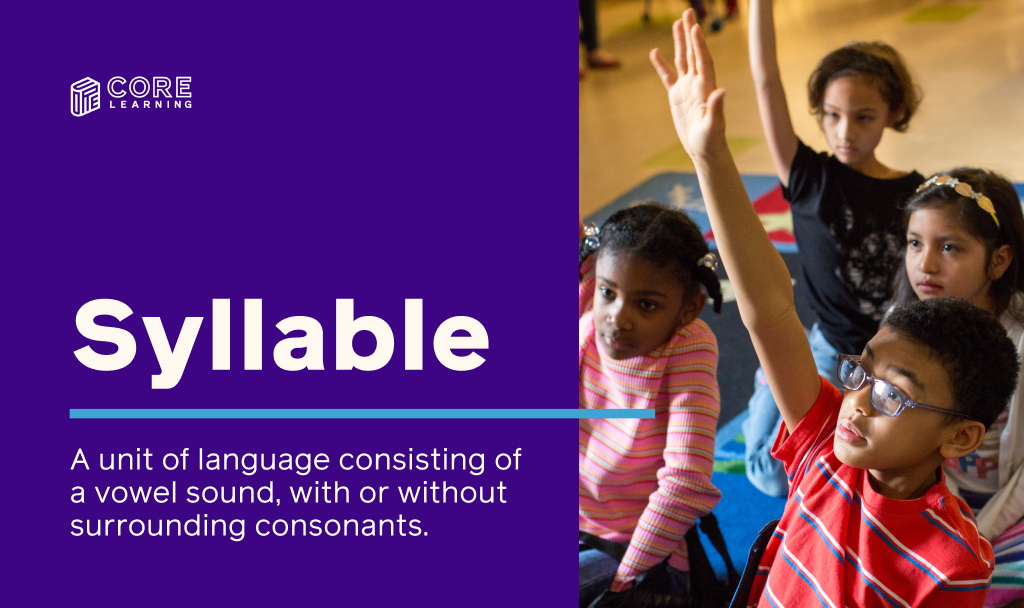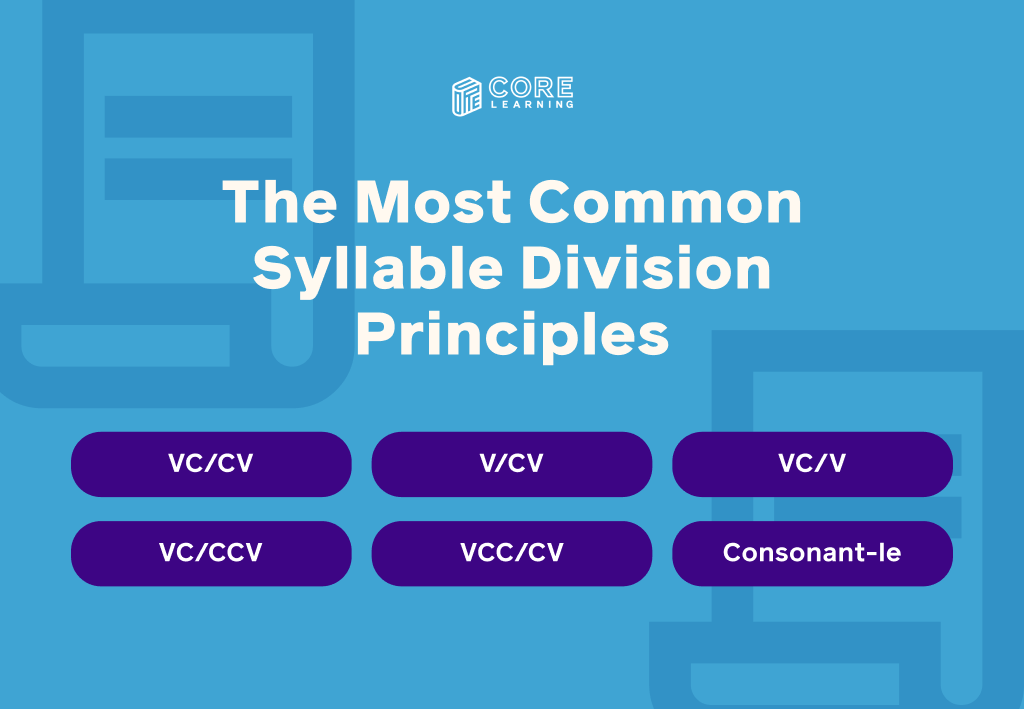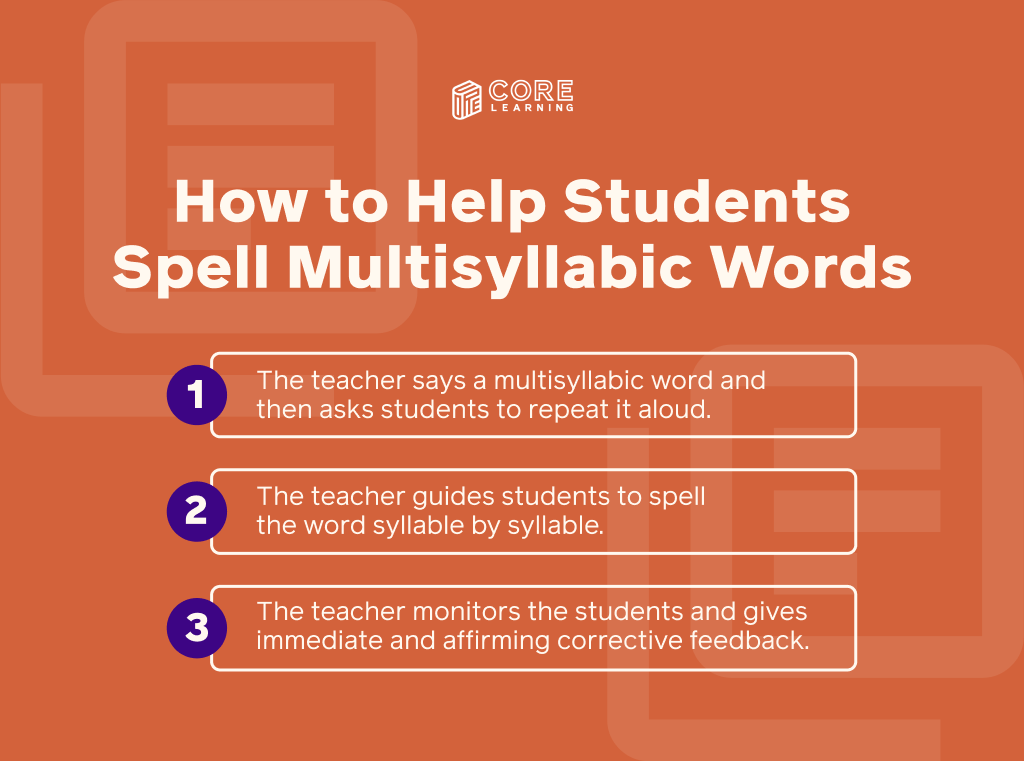Reading is a fundamental skill that requires explicit instruction and evidence-based approaches, as emphasized by the science of reading. A crucial aspect of this process is the ability to decode multisyllabic words, which is pivotal to reading fluently and spelling accurately.
A syllable is a unit of language consisting of a vowel sound, with or without surrounding consonants. Every syllable has one vowel sound. Knowing how to break words into syllables can help with reading accuracy, pace of reading, and spelling.

Reading single-syllable words is usually straightforward. For example, the words cat and dog each have one syllable (one vowel sound). When provided with explicit instruction and practice, students can typically map each sound in a one-syllable word onto its corresponding letter(s) with comparatively little confusion as to which letter(s) maps to which sound. However, multisyllabic words—words containing two or more syllables—have more sound/spelling correspondences and syllabic units to process and remember, making it more challenging to read and spell correctly.
For example, the word category has four syllables: /cat-eg-or-y/. The third syllable, “eg” has the schwa sound /ə/, which can make it more challenging to pronounce and spell it correctly. Similarly, the word beautiful has three syllables /beau-ti-ful/ but doesn’t follow the usual English spelling rules. The /ū/ in the first syllable is spelled based on the French word for beautiful, beau, making it more difficult to spell the syllable correctly.
Multisyllabic words are very common in the English language. In fact, most of the words in the Oxford English dictionary are multisyllabic. Not being able to read and spell multisyllabic words accurately can seriously hinder fluency and, thus, comprehension, causing a student to lose out on much of what they’re reading.
Effective reading and spelling instruction follows a systematic sequence that helps students grasp the concept of syllables as they progress from monosyllabic to multisyllabic words.
How to Help Students Read Multisyllabic Words
Many single-syllable words can be sounded using basic phonics rules taught in kindergarten and first grade. For example, with single syllables, /a/ is the vowel sound in the word cat. There is little confusion in pronunciation.
However, things can get complex as students progress to multisyllabic word reading. These words are longer and have more than one vowel sound to identify. The vowel sounds (and spellings) are critical for the accurate pronunciation of longer words.
Therefore, we teach students to recognize six common syllable types based on the vowel sounds: closed (one vowel letter, short sound); open (single vowel at the end of a syllable, long sound); vowel team (vowel or vowel-consonant combination, short, long or diphthong sound); r-controlled (r+vowel spelling); vowel-consonant e (long vowel sound); and consonant -le (final syllable with the schwa vowel sound. More information about the six syllable types can be found on pages 262-263 of the Teaching Reading Sourcebook.
These syllable types are the underpinnings for the four most common syllable division principles: VC/CV, V/CV or VC/V, VC/CCV or VCC/CV, and Consonant-le. These divisions are taught to support students’ accurate pronunciation of longer unknown words.

In addition, common prefixes and suffixes (affixes) are explicitly taught to help students notice these common parts of longer words and to read them with increased automaticity. Teaching the meaning of each affix supports students’ morphological knowledge and can be applied when encountering new, longer words in texts.
These examples of multisyllabic word instruction affect both fluency and comprehension. If a student struggles to read a multisyllabic word, they will also struggle to understand its meaning. This is because multisyllabic words often carry the most meaning in the text: if a student misses these words, they are likely to miss the main point of the text. Therefore, it’s essential to provide students with instruction on reading and understanding multisyllabic words.
How to Help Students Spell Multisyllabic Words
In general, one of the best ways to teach spelling is through guided dictation. Guided dictation allows students to work specifically on the sound-spellings relationships, giving them an opportunity to listen to the sounds in syllables and write the spellings and patterns of written English.
With guided dictation, the teacher says a multisyllabic word and then asks students to repeat it aloud. By pronouncing the word, the students create a phonological representation of the word. Next, the teacher guides students to spell the word syllable by syllable, writing one syllable at a time. The teacher monitors the students as they write and gives immediate and affirming corrective feedback. Unlike a weekly spelling test, this is guided practice to spell multisyllabic words.

CORE Learning partners with Collaborative Classroom, the publisher of SIPPS. In the Challenge level of SIPPS, guided dictation with multisyllabic words occurs. (SIPPS refers to this instructional routine as Guided Spelling.) In this instructional routine, educators follow the steps outlined above. In the Beginning and Extension levels of SIPPS, guided dictation of single-syllable words occurs.
Here is an example of how a teacher guides students’ practice during guided dictation:
When the teacher dictates the word fright, for example, which is a long “i” vowel sound, there may be questions or confusion as to how to spell the long i in that word because the long i can be spelled multiple ways, e.g., igh, i_e, -y or just i. Teachers train students to ask, “Which [long] i?” as part of the spelling practice. In response to the question, the teacher explicitly shows the students the correct spelling for long i by pointing to the sound-spelling card for long i. This process that provides constant feedback, over time, helps students internalize the correct spellings.
The Role of Morphology in Reading Longer Words
Morphology is the study of the structure of words. It’s concerned with how words are formed from smaller units of meaning, such as prefixes and suffixes, as well as Greek and Latin root words. Instruction that focuses on morphology can help students develop a deeper understanding of how longer words work, enabling them to read and spell multisyllabic words more efficiently and accurately. This focus is supported through vocabulary instruction on word-learning strategies.
This blog focused on the decoding aspects of reading and spelling multisyllabic words. In an upcoming blog, we will address the role of morphology and how it can help students read, spell, and understand multisyllabic words.
CORE Learning Teaching Reading Sourcebook
CORE’s Teaching Reading Sourcebook is a comprehensive resource that seamlessly combines a research-informed knowledge repository with tangible sample lesson plans. It serves as an instructive tool for educators, imparting the fundamental components of a successful reading program: phonemic awareness, decoding skills, vocabulary enhancement, fluency, and comprehension.
This valuable resource offers a hands-on approach, serving as an essential guide for teachers as they work to enhance students’ reading proficiency. You can preview the sourcebook by clicking here.
This is the second piece in a series on Structured Literacy. You can read the first piece, “What Is Structured Literacy? An Introduction” by Dale W. Webster, Ph.D., Vice President of Language & Literacy, here.








